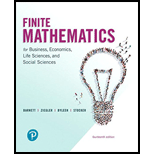
In Problems 1-6, identify the absorbing states in the indicated transition matrix.
Want to see the full answer?
Check out a sample textbook solution
Chapter 9 Solutions
Finite Mathematics for Business, Economics, Life Sciences and Social Sciences
Additional Math Textbook Solutions
A Problem Solving Approach to Mathematics for Elementary School Teachers (12th Edition)
Thinking Mathematically (7th Edition)
A Survey of Mathematics with Applications (10th Edition) - Standalone book
Thinking Mathematically (6th Edition)
Probability and Statistics for Engineers and Scientists
- Milan.sttarrow_forwardQuestion 3 a. An analog communication system with random variable X has probability density function f(x) defined by kx", f(x) ={k(2-x²), -l1 Determine i. the value of k. ii. F(x) iii. o, iv. Sketch the graph of f(x) and F(x). b. Consider a communication channel where each substation transmits and receive data. The probability between the substations is shown in figure 3.arrow_forward2.Initially we have 2 red marbles in Box 1 and 2 white marble in Box 2. At every time step, we take a marble from each box and swap. Let Xt be the number of red marbles in Box 1 at time t. There are 3 states: 0, 1, 2. Let P be the transition matrix for {X;}, what is (P)oo (probability from state 0 to state 0)?arrow_forward
- In the Heidman’s Department Store problem of Unit 2 of this module, suppose that the following transition matrix is appropriate:If Heidman’s has $4000 in the 0–30-day category and $5000 in the 31–90-day category what is your estimate of the amount of bad debts the company will experience?arrow_forwardIn some country, 90% of the daughters of working women also work and 20% of the daughters of nonworking women work. Assume that these percents remains 0.9 0.2 unchanged from one generation to the next. The corresponding transition matrix is A = 0.1 0.8 Consider a typical group of women, of whom 45% currently work. Use A and A² to determine the proportion of working women in the next two generations. The proportion of working women in the first generation is %. (Type an integer or a decimal.) %. The proportion of working women in the second generation is (Type an integer or a decimal.)arrow_forwardLet us have the experience of a mouse falling into a trap inside a 6-room building, as shown in the figure below. If the room contains k doors, the probability that the mouse will choose one of these doors is 1/k if the mouse reaches room F that contains the food or room S that contains the trap. It will stay there and the experiment ends, the transition matrix is M= [0.5 0 0.5 0 0.3 0 0 ¹0.5 0 0 0.3 0.3 0 0.3 0.3 0 0.5 0 000 O a O b О с 2 000 0.5 0 0.5 0 0 0 0 0.3 0 0.5 0 0.5 M = - 0 0.5 0.5 b 3 ..+. 4 5 0 0 S M= 0 0 0 1 0 0.5 0 0 0 0 0.5 0 0 0.3 0.3 0 0 0.3 0 0.5 0 0 0.5 0 0 1 00000 10 0 000 0.5 0 0 0.5 0 0.3 0 0.3 0.3 0 0.3 0.3 0 0 0 0.5 0 0 000 0 0 0 0 C 0 0 0.3 0.5 1 (a)arrow_forward
- A financial company has assets in countries A, B and C. Each year f of the money invested in country A stays in country A, of the money invested in country A goes to country B and the remainder (if any) moves to country C each. For country B and C, of the money stays in each country and the remainder is invested in country A. What is the transition matrix T for this dynamical system? T = In the steady state, what is the percentage of the assets of the company that are invested in country A? (e.g. if 40% input 0.40) number (2 digits after decimal)arrow_forward2. Consider the tournament whose adjacency matrix is 0 01 0 1 1 1 1 1 1 1 1 0 0 0 T = |0 1 1 0 1 0 0 1 0 0 0 0- 1 1 1 1 1 1 l1 0 1 1 Here, Tij = 1 if player i defeated player j in the tournament.arrow_forwardstate 1[.1 .1 .8 1. Consider the transition matrix P= state 2.5 5 0 state 3.7 0 3 a. Identify what the entry in row one, column three (the .8) represents: b. Find p (use your calculator. no work required): c. Identify what the entry in row two, column one of represents.arrow_forward
 Discrete Mathematics and Its Applications ( 8th I...MathISBN:9781259676512Author:Kenneth H RosenPublisher:McGraw-Hill Education
Discrete Mathematics and Its Applications ( 8th I...MathISBN:9781259676512Author:Kenneth H RosenPublisher:McGraw-Hill Education Mathematics for Elementary Teachers with Activiti...MathISBN:9780134392790Author:Beckmann, SybillaPublisher:PEARSON
Mathematics for Elementary Teachers with Activiti...MathISBN:9780134392790Author:Beckmann, SybillaPublisher:PEARSON
 Thinking Mathematically (7th Edition)MathISBN:9780134683713Author:Robert F. BlitzerPublisher:PEARSON
Thinking Mathematically (7th Edition)MathISBN:9780134683713Author:Robert F. BlitzerPublisher:PEARSON Discrete Mathematics With ApplicationsMathISBN:9781337694193Author:EPP, Susanna S.Publisher:Cengage Learning,
Discrete Mathematics With ApplicationsMathISBN:9781337694193Author:EPP, Susanna S.Publisher:Cengage Learning, Pathways To Math Literacy (looseleaf)MathISBN:9781259985607Author:David Sobecki Professor, Brian A. MercerPublisher:McGraw-Hill Education
Pathways To Math Literacy (looseleaf)MathISBN:9781259985607Author:David Sobecki Professor, Brian A. MercerPublisher:McGraw-Hill Education





